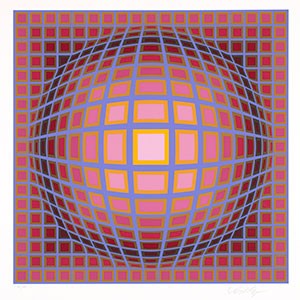A new exhibition explores optical illusions, three-dimensional art and abstraction at the Fred Jones Jr. Museum of Art. Into the Void, a new exhibition of 1960s Op art curated by University of Oklahoma students, opens to the public Saturday, Feb. 9.
A guest lecture by the student curators at 6 p.m. Friday, Feb. 8, will precede an opening reception for Museum Association members at 7 p.m. The exhibition opens to the public Feb. 9.
Into the Void is a student-curated printmaking exhibition featuring works from the FJJMA permanent collection by such artists as Victor Vasarely, Bridget Riley and Richard Anuskiewicz. The exhibition is curated by OU School of Art and Art History students Allison Campbell, Andrea Duran, Laura Fortner, Alexa Healey, Theresa Hultberg and Jessica Schlarb.
“The Fred Jones Jr. Museum of Art has had wonderful success with exhibitions curated by OU School of Art and Art History students in recent years,” said Ghislain d’Humières, FJJMA director. “As a university museum, student collaborations not only promote student interaction with the museum’s collections, it also gives viewers a unique perspective into the minds of students. This visually stimulating exhibition will surely be popular with visitors of all ages.”
According to the student curators, the exhibition is a sensory experience that encompasses the entire optical spectrum and is a modern ode to a few of the founding members of the Optical art movement, which originated in the mid-1950s. By 1964, Optical art was dubbed “Op art.”
“The Op art movement deals with having a visual experience generated by a specific piece, so it does not require previous knowledge of the movement in order to understand or enjoy the work,” said Healey, an art history and art studio major from Ardmore with an emphasis in painting and printmaking. “My favorite part of the process was researching the individual artists in the show. Although they are a part of the same movement and have similar philosophies, they are all uniquely different in their process.”
In the decade of Civil Rights, feminism and the Vietnam War, a strong counterculture developed out of distrust for authoritarian control. Op artists were equally suspicious of authoritative or artistic control of meaning in a work of art. To avoid perceived symbolism, Op artists used mathematical formulae and geometric forms that are customarily devoid of prescribed meaning.
“We selected Op art for the Into the Void exhibition because it is not only a very eye-catching style, but it is a style whose history and purpose is not common knowledge,” said Hultberg, a studio arts junior from Oklahoma City. “We believed it was a great opportunity to give optical art a rebirth of sorts, to possibly spark new interest from the creative community for the Op art movement.”
Op artists explore the principles of perception through the use of line, color and light, thus creating an optical illusion. Any artwork that suggests a three-dimensional space on a two-dimensional surface is an illusion, but Op artists use abstract shapes and line to produce optical sensations free of subject matter.
Any meaning in Op art ultimately rests with the viewer and their psychological and physical response to the work.
Campbell, an art history senior from Tulsa, said she hopes the exhibition persuades visitors to enjoy art for the fun of it.
“Creative expression is found in a myriad of different configurations,” Campbell said. “I hope visitors leave Into the Void with a renewed inclination for viewing art simply for the eye’s pleasure.”
The student curators were involved in the majority of the planning of the exhibition, including selecting works for display, conducting research, writing and designing a gallery guide, and even designing an original logo for the exhibit.
“This show was so fun to work on because of its highly visual nature, and I hope that visitors can enjoy the experience the art creates,” said Fortner, a visual communications junior from Flower Mound, Texas. “I had the best time seeing our work around town and campus and to be a part of a team of students putting this all together.”
Into the Void runs through July 28 in the museum’s Ellen and Richard L. Sandor Photography Gallery.
The Fred Jones Jr. Museum of Art is located in the OU Arts District on the corner of Elm Avenue and Boyd Street, at 555 Elm Ave., on the OU Norman campus.
Admission to the museum is complimentary to all visitors, thanks to a generous gift from the OU Athletics Department. The museum is closed on Mondays. Information and accommodations on the basis of disability are available by calling (405) 325-4938 or visiting www.ou.edu/fjjma.



